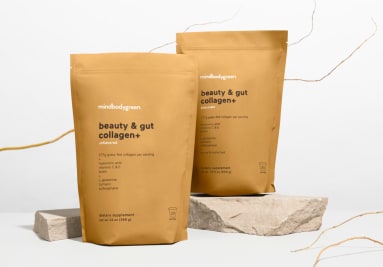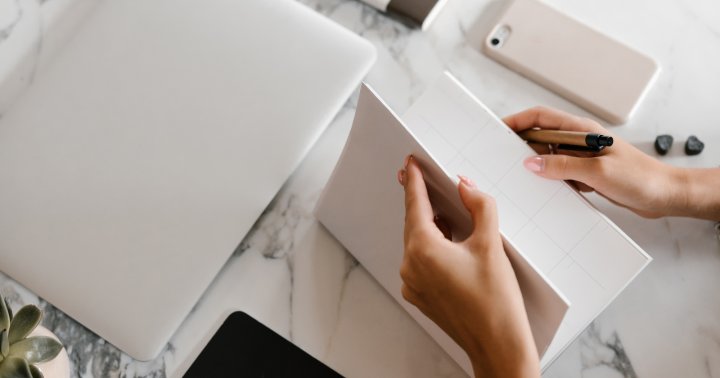Is This Skin Care Trend Making People More Insecure?
Innovations in the beauty space can be a very beautiful, or a very problematic thing.


mbg Assistant Beauty Editor
mbg Assistant Beauty Editor
Hannah Frye is the Assistant Beauty Editor at mindbodygreen. She has a B.S. in journalism and a minor in women’s, gender, and queer studies from California Polytechnic State University, San Luis Obispo. Hannah has written across lifestyle sections including health, wellness, sustainability, personal development, and more.
Image by Stocksy // Demetr White November 18, 2022 Our editors have independently chosen the products listed on this page. If you purchase something mentioned in this article, we may Innovations in the beauty space can be a very beautiful, or a very problematic thing. When novel tools and products hit the market that help someone feel better about themselves or take better care of their skin, hair, or nails—that's great. However when products pop up out of nowhere that breed new insecurities for the masses... that's anything but pretty. The obsession with getting rid of peach fuzz is one highly contradictory topic for this reason (and more that you'll read about below). So we're here to answer all of your questions. To follow, you can read all about the benefits, the risks, and some food for thought on dermaplaning. Let's dive in, shall we?
Advertisement
This ad is displayed using third party content and we do not control its accessibility features.
What is dermaplaning?
Dermaplaning sounds intense, but it’s fairly straightforward—it’s the process of shaving the face with a super sharp blade to remove peach fuzz and the top layer of your skin. Dermaplaning is the same thing as dermablading, microblading, or blading, just in different words.
This can be done by a professional or DIY-style, though we’re not huge fans of the latter (more on that in a bit). Dermaplaning was not always a trend, but in recent years it’s become more desirable and even seen as an essential step for nailing the sought-after, “glass skin,” look.
Why is dermaplaning so popular?
At the height of the Youtube beauty tutorials (say, 10 years ago or so), dermaplaning started to really take off. The beauty influencers of the early days would use this technique to help their makeup lay better on the skin and induce an instant glow.
This obsession with capturing a “perfect” image of the skin or a full-glam makeup look was a major flex during this time, and people would go to further lengths to get it—including shaving off their peach fuzz.
While peach fuzz is something everyone has, some people have demonized it to the point of creating societal pressure to remove it. As if we don't have enough things we’ve been conditioned to be insecure about already.
It’s worth noting that times are certainly shifting in the beauty industry—and it’s (for the most part) for the best. Gen-Z is embracing imperfections by placing value on the artistic side of makeup, using it as vehicle for self-expression, and viewing skin care as self care—AKA, the opposite of a goal-based approach to nailing a "flawless" look.
Not to mention, shaving the face is a form of physical exfoliation, which is where that dewy glow comes from. It makes sense that dermaplaning was most popular during the hight of exfoliation obsessions—when stronger, more potent acids and extreme face scrubs were all the rage.
Now we’re seeing gentle chemical exfoliants replace once sought-after microplastic beads and we’re even scheduling in “recovery nights” to ensure our skin gets a break from all of the actives. Barrier repair creams, serums, and masks are selling out faster than ever—and this is a good thing.
Nevertheless, some people are still into dermaplaing, and plenty of people are asking whether it’s a must-do step—here’s what the experts have to say.
Advertisement
This ad is displayed using third party content and we do not control its accessibility features.
Let's evaluate: What exactly can dermaplaning do?
Dermaplaning does have benefits—some obvious, some not as much. Here are the basic positive effects you can expect:
Removes peach fuzz.
"Everyone has fine vellus hairs on their face, but some people's vellus hairs are thicker and more visible than others, so they may want to have these hairs removed,” board-certified dermatologist Hadley King, M.D. tells mbg.
Advertisement
This ad is displayed using third party content and we do not control its accessibility features.
Removes the top layer of the epidermis.
With the vellus hairs comes the top layer of the epidermis— “The superficial layer of dead skin,” as King describes it. Like other forms of exfoliation, removing dead skin will help to brighten your complexion.
Can be a useful tool for makeup artists and those on camera.
Dermaplaning makes the most sense for makeup artists, those who are on camera, or those who wear full-glam makeup regularly and need their base products to sit flat.
Removing peach fuzz does lead to easier makeup application and a smoother canvas. So if any of these apply to you, then dermaplaning may be worth it! However, it’s safe to say that most of us are not working with up-close cameras all day long.
Advertisement
This ad is displayed using third party content and we do not control its accessibility features.
PSA: The Potential consequences.
To state the obvious, you are touching a sharp blade to your facial skin—and not a protected, gelly-covered one, either. Dermaplaning can be dangerous, and a proper DIY job is much more nuanced than just shaving the face (more on that in a bit).
What’s more, if you accidentally knick your skin too deeply or hit a pimple, ingrown hair, or other kinds of inflamed skin, you run the risk of infection.
Finally if you’re not careful, you can damage your skin barrier by over-exfoliating. This could mean using it too often, going over the same area more than once, using irritating products afterward, etc. To sum up—the risks generally outweigh the benefits.
So is it worth it? What to consider.
Dermaplaining is an investment in regard to time and money—especially if you’re getting it done by a professional. So is it worth it? Well, here’s a bit of food for thought to help you decide for yourself.
Advertisement
This ad is displayed using third party content and we do not control its accessibility features.
Peach fuzz is normal.
Let’s be very clear—if you have been insecure about your peach fuzz for years and always see it when you look in the mirror, or you notice that it directly impacts your self-esteem, then by all means don’t let anyone stop you from dermaplaning (but do it safely of course). If something is going to make you feel more confident and help you be more present in your life, it’s nobody else’s business.
However, if you haven’t really thought about your peach fuzz too much until you heard about dermaplaning, then you might be adopting a media-induced insecurity. While sharing insecurities online can help us feel connected, it can also result in people picking up new insecurities they didn’t have before, which is exactly the opposite of what the world of beauty standards needs right now.
This is kind of like the face symmetry trend from a few months back—some people never thought about whether or not their face was symmetrical until a filter showed them the results—these are new insecurities that may not even be yours to begin with, so try to keep that in mind.
There are much better, more effective ways to exfoliate.
One of the main benefits of dermaplaning is exfoliation—but let us remind you that there is definitely more ways to exfoliate and many of them are more effective than taking a blade to the skin—more on this to follow.
It can be expensive.
Another thing—dermaplaning can be expensive. If you choose to invest in a safe and high-quality tool to use on yourself, it can be a few hundred bucks. Plus, you’ll have to be extremely diligent about cleaning the tool every single time.
If you chooe to visit a professional, it can cost upwards of $150 as well for a single session. Not to mention, that’s a chunk out of your day you’ll be setting aside.
It's not for all skin types.
If you have the following skin conditions, you should most definitely stay away from dermaplaning—period:
Should you do dermaplaning on yourself?
If you are married to the idea of dermaplaning and have access to a professional who can do it for you, we recommend taking that route. “A trained esthetician will know exactly how many passes to do over the skin, so there's no danger of getting too much (or too little) exfoliation," says celebrity esthetician Renée Rouleau.
Plus, the pros use high-tech tools to follow up treatments such as professional-grade LED lights or facial ultrasound machines. These you simply can't replicate at home; according to Rouleau, "A cold ultrasound can hydrate the new cells with potent antioxidants to soothe inflammation and reduce post-procedure redness."
If you must dermaplane at home, remember this.
Should you choose to do it at home, King recommends keeping these tips in mind:
Is dermaplaning the same as shaving?
No—dermaplaning is not the same as shaving. Allow us to elaborate—dermaplaning is different from shaving the face because of the blade. The ultra-sharp dermaplaning blade removes hair and targets the top layer of the skin—which is where many of the risks come in. Shaving, however, simply removes the hair.
So if you decide to remove facial hair for any reason—do your thing, especially if it will make you feel better about yourself and be more present. But using a high-quality facial razor is a safer option than dermplaning. Plus, for thicker hairs, a facial razor will be more effective, too.
And if you want a more permanent solution—again especially for thicker, darker hairs—King recommends laser hair removal; you can read more about that here if you're curious.
In case you need to exfoliate, here are some better options:
If you’re ready to start exfoliating, or just want to learn more about your other options, here’s a quick overview:
There’s an array of chemical exfoliant out there, from extra-gentle poly-hydroxy acids, brightening alpha-hydroxy acids and acne-fighting beta-hydroxy acids—all of which also lead to a brighter complexion and remove dead skin.
Some of them even have multiple benefits:
Even gentle (and we mean very gentle) facial scrubs can have additional benefits—including that instant glow. If you need to lift excess dead skin ASAP (say, for a smooth makeup canvas, for example), then a gentle physcial scrub may be the way to go.
If you don’t want to use a scrub, you can also use a gentle damp rag to massage your cleanser into the skin. This will help to gently exfoliate, too—just don’t rub too hard.
The takeaway.
That was a lot, so to sum up: Peach fuzz is normal, and you don't need to remove it if you don't want to. And if you do, well that's totally your choice as well! It's just that for exfoliation, chemical exfoliants, retinol, and gentle facial scrubs tend to be more effective options. And if you want to remove facial hair, opt for a facial razor instead. Want more exfoliation tips? Here's a guide to exfoliation any skin type can follow.

 MikeTyes
MikeTyes 
































